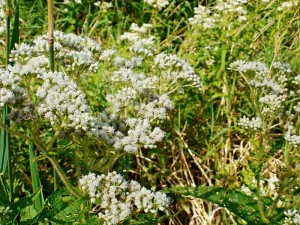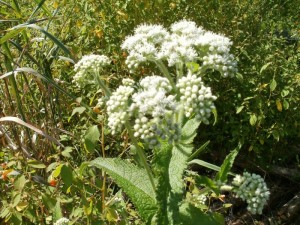The fields and meadows of the eastern United States and Canada are turning white. The native perennial herb, Boneset, is blooming. The white blooms appear in August and the display usually runs through the end of September. The white blossoms were valauable medicine to many in the early days. Today, boneset is largely forgotten,.
I was fortunate one day to meet a logger who was checking a timber stand one day. As we were leaving the woods and walking into a field, he pointed the boneset plants out. For as long as I can remember, the plants were always there, year after year, but was unsure of what they were.
Boneset, technically known as Eupatorium perfoliatum, usually grows in moist areas of the fields. It’s white blossoms are produced on the top of hairy stalks. The stalks can be upwards of five to six feet feet tall. Often the herb can often be found growing among another important native plants; the golden yellow goldenrod, the deep purple wild asters, the shades of glowing pink Joe Pye Weed and the orange flowers of native Jewelweed. Boneset helps to provide quite the stunning flower show, free of all charge.
Boneset was an important medicinal herb and still has a place in a few medicine cabinets. Boneset was a well known and an important medicinal to the Native Americans, the early pioneers and to most rural American families until the early to mid -1900’s. The blossoms had a message, get ready flu and cold season is coming.
Boneset was used much like we use any aspirin today. It was widely prescribed to help the pain of broken bones and aid in their healing. Boneset was a common remedy for coughs, fevers and was the early stand-out treatment for the treating the flu. Interestingly, influenza or the word flu was not a common word for the pioneers. The term “break bone fever” (boneset) described what is commonly called the flu or influenza today.
Boneset was also used to treat other ailments such as malaria, rheumatism and pneumonia, arthritis and even migraines.
Originally, the herb boneset was used as a poultice and then a boneset tea became more popular.
The logger explained that the time to harvest the Boneset plant was when it was blooming. He said it makes a good tea, although it was somewhat on the bitter side. He was first introduced to the herb by some older loggers when he was younger, some twenty years ago. They would drink the tea a couple times a day when taking a break from cutting timber.
Boneset’s popularity went downhill in the early 1900’s and was largely forgotten after a new miracle drug from the bark of the willow tree was introduced. Aspirin was first sold in tablet form in 1915 by the German pharmaceutical company, Bayer. Soon afterward, boneset began to loose it’s importance. Today, aspirin has a special place today in medicine cabinets throughout the world, while the dried leaves and flowers of the boneset, have all but disappeared.
Interestingly, boneset does have a rather intriguing family tree, I discovered. It is in the same family tree as sunflowers, enchinea and daisy. One of it’s closer relatives is another important medicinal plant Joe Pye Weed.
Boneset is known by other names, depending on the region. It is also called agueweed, thoroughwort, and Indian sage. But regardless of it’s name, it was always considered one of the most effective medicinals.
As with any herbal home remedy it is always a good idea to consult with a medical professional. There are some indications that some people may have negative reactions to the herb. Apparently, however, there have been no exhaustive studies completed on it’s value although some valuable properties in the plant have been identified.
Boneset is harvested when it blossoms The plant should be dried before using; using the plant green, herbal wisdom claims, can be toxic. Most herbalists recommend using the dried flowers and leaves for a tea, about ½ teaspoon per cup. Most home herbalist recommend three cups per day. For most people, the tea has a bitter taste and will induce sweating by raising the body temperature.
Many herbalists recommend discontinuing use of the tea after a two week period. For some, the plant’s herbal tea relieves symptoms within a twenty-four to 48 hour period.
While for some, boneset could be a valuable home remedy, medical plant, other see another value. Boneset is an excellent landscaping plant, particularly for a “wild” chemical free area of the yard. Boneset, a carefree perennial, can be planted with any number of other plants such as the native asters, Joe Pye Weed, the golden yellow goldenrod and other native plants to provide a wild garden which blooms throughout the seasons.. The added advantage is that boneset, like other native plants will attract many helpful native insects, butterflies and birds.
After the logger left for the day, I went back to field of boneset. I was amazed at the insect activity on the flowers, including the feral honeybees and many others which I did not recognize.
I’ll be cutting some soon to dry out, after all the cold and flu season is approaching, and try to learn about some of the other insects. It sure seems as if boneset, the original “aspirin”, remains a good choice for health benefits, landscaping and for the bees and other insects. It won’t be the forgotten herb growing in a nearby field.
Discover more about wild herbs, gardening, honey bees and more issues of rural concerns at Koyote Hill


